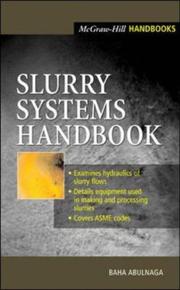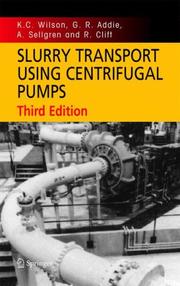| Listing 1 - 7 of 7 |
Sort by
|
Book
Year: 1978 Publisher: Washington, D.C. : Congress of the United States, Office of Technology Assessment,
Abstract | Keywords | Export | Availability | Bookmark
 Loading...
Loading...Choose an application
- Reference Manager
- EndNote
- RefWorks (Direct export to RefWorks)

ISBN: 0071375082 Year: 2002 Publisher: New York : McGraw-Hill,
Abstract | Keywords | Export | Availability | Bookmark
 Loading...
Loading...Choose an application
- Reference Manager
- EndNote
- RefWorks (Direct export to RefWorks)
The most comprehensive resource on slurries and slurry systems, covering everything from fluid mechanics to soil classification, pump design to selection criteria. Slurries are mixtures of liquids and solid particles of all types. For instance, liquid is used as a way of transporting what you get out of the mine, which might be better than shoveling it into freight cars and carrying it out by train. Slurry systems are fundamental to dredging, many mineral processes, bridge and tunnel construction, and to the manufacturer of synthetic petroleum products from oil sands.
Book
Year: 1978 Publisher: Washington, D.C. : Congress of the United States, Office of Technology Assessment,
Abstract | Keywords | Export | Availability | Bookmark
 Loading...
Loading...Choose an application
- Reference Manager
- EndNote
- RefWorks (Direct export to RefWorks)
Book
Year: 1979 Publisher: Washington, D.C. : United States Nuclear Regulatory Commission, Office of Inspection and Enforcement,
Abstract | Keywords | Export | Availability | Bookmark
 Loading...
Loading...Choose an application
- Reference Manager
- EndNote
- RefWorks (Direct export to RefWorks)
Radioactive waste disposal --- Slurry pipelines. --- Waste spills. --- Accidents --- United States.
Book
Year: 1979 Publisher: Washington, D.C. : United States Nuclear Regulatory Commission, Office of Inspection and Enforcement,
Abstract | Keywords | Export | Availability | Bookmark
 Loading...
Loading...Choose an application
- Reference Manager
- EndNote
- RefWorks (Direct export to RefWorks)
Radioactive waste disposal --- Slurry pipelines. --- Waste spills. --- Radioactive waste disposal --- Slurry pipelines. --- Waste spills. --- Accidents --- Accidents. --- United States.
Multi
ISBN: 9783031254406 9783031254390 9783031254413 9783031254420 Year: 2023 Publisher: Cham, Switzerland : Springer Nature Switzerland AG,
Abstract | Keywords | Export | Availability | Bookmark
 Loading...
Loading...Choose an application
- Reference Manager
- EndNote
- RefWorks (Direct export to RefWorks)
Based on the industry leading short course “Transportation of Solids using Centrifugal Pumps,” founded by Dr. Kenneth Wilson and Graeme Addie, and hosted by the GIW Industries Hydraulic Laboratory, this expanded fourth edition has been extensively updated by the international team of engineers and authors who inherited this legacy and continue its development to the present day. Focusing on the hydraulic design of slurry pipelines, the pumps that power them, and the interactions between pumps and systems, it retains the classroom tested balance of theoretical development and practical engineering which have made it a slurry transport classic. The topics covered are important to slurry system engineers for the optimization of new designs, as well as the operators of existing systems, who may need to calculate and plan for changing conditions from day to day. Updates to the fourth edition include: Careful formulation of the theoretical concepts, providing greater clarity of slurry flow dynamics, including a new chapter on the principles and characterization of slurry flows. Expansion of the 4-Component Models for settling slurry pipeline flow and pump solids effect, based on an extensive series of full-sized tests. An expanded treatment of complex slurries, including a broader discussion of non-Newtonian fluids and their interaction with coarse particles. A new chapter on test methods, presenting an overview of slurry system instrumentation, modern techniques for characterizing slurry rheology, and practical advice for planning and executing a slurry test. An overview of advances in the computational modeling of slurries, including an in-depth parametric study of slurry pump wear and operating cost. The authors highlight methods for achieving energy efficiency, which are crucial to the effective use of scarce resources, given the foundational role of slurry transport systems in the energy intensive industries of mining and dredging. Key concepts are supported with case studies and worked examples. Slurry Transport Using Centrifugal Pumps, fourth edition, is both methodical and in-depth. It is ideal as a teaching tool for classroom or self-directed learning domains, and valuable as a design guide for engineer practitioners at all experience levels. Stands as an authoritative reference for engineers in the dredging, mining, mineral and chemical processing industries; Incorporates the latest advances in the field, including both theory and practice. Reinforces concepts presented with worked solutions and case studies.
Fluid mechanics --- Hydraulic energy --- Mining industry --- Fuels --- mijnbouw --- ingenieurswetenschappen --- hydraulica --- fossiele brandstoffen --- vloeistoffen --- Centrifugal pumps. --- Slurry pipelines.

ISBN: 1280611995 9786610611997 038723263X 0387232621 1441935916 Year: 2006 Publisher: New York ; [London] : Springer,
Abstract | Keywords | Export | Availability | Bookmark
 Loading...
Loading...Choose an application
- Reference Manager
- EndNote
- RefWorks (Direct export to RefWorks)
1,1 Applications of Slurry Transport Vast tonnages are pumped every year in the form of solid-liquid mixtures, known as slurries. The application which involves the largest quantities is the dredging industry, continually maintaining navigation in harbours and rivers, altering coastlines and winning material for landfill and construction purposes. As a single dredge may be required to maintain a throughput of 7000 tonnes of slurry per hour or more, very large centrifugal pumps are used. Figures 1-1 and 1-2 show, respectively, an exterior view of this type of pump, and a view of a large dredge-pump impeller (Addie & Helmley, 1989). The manufacture of fertiliser is another process involving massive slur- transport operations. Li Florida, phosphate matrix is recovered by huge draglines in open-pit mining operations. It is then slurried, and pumped to the wash plants through pipelines with a typical length of about 10 kilometres. Each year some 34 million tonnes of matrix are transported in this manner. This industry employs centrifugal pumps that are generally smaller than those used in large dredges, but impeller diameters up to 1. 4 m are common, and drive capacity is often in excess of 1000 kW. The transport distance is typically longer than for dredging applications, and Chapter 1 Figure LI. Testing a dredge pump at the GIW Hydraulic Laboratory Figure 1. 2. Impeller for large dredge pump 1. Introduction 3 hence a series of pumping stations is often used. Figure 1-3 shows a boost- pump installation in a phosphate pipeline.
Slurry pipelines. --- Centrifugal pumps. --- Pumps, Centrifugal --- Hydraulic machinery --- Pumping machinery --- Slurry --- Solids pipelines --- Pipelines --- Pipe lines --- Mechanical engineering. --- Civil engineering. --- Mechanical Engineering. --- Civil Engineering. --- Engineering --- Public works --- Engineering, Mechanical --- Machinery --- Steam engineering
| Listing 1 - 7 of 7 |
Sort by
|

 Search
Search Feedback
Feedback About
About Help
Help News
News